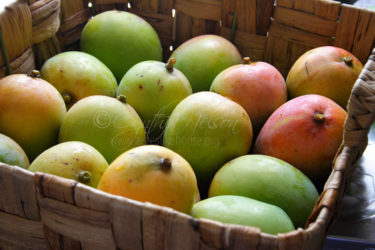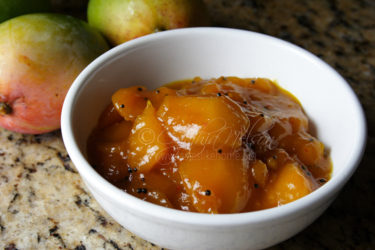The season for huge, fist-sized, yellow to orange flesh, fragrant, juicy, sweet mangoes, will soon be upon us. The trees across the island are in varying stages – some full of blossoms, some densely populated with young fruit and others with branches bowing with the weight of those signalling that they will soon be ready to be picked. It’s coming, mango season, and I can’t wait for it to get here.
I can’t wait to hold my first mango of the season – firm, ripe, and sweet smelling, cupped in the palm of my hand. How shall I have my first taste of the season? Should I roll the mango to soften the flesh, make a small bite at the opposite end of the stem and suck on it? Should I tear the skin with my teeth and bite into the flesh, the juices running down the sides of my chin? Should I make deep slices of the sides dividing the mango into three pieces, scraping the flesh with my teeth with the skin intact? Leaving the seed with its surrounding band of flesh for last? Very important decisions to be made.
I am looking forward to late, long, sunny weekend afternoons with fruity, boozy mango drinks, morning breakfast and afternoon snacking of a bowl full of ripe mangoes, sometimes with a light sprinkling of flaked sea salt to dance on my tongue. Perhaps I will drizzle a few slices with Kecap Manis (Indonesian sweet soy sauce) with its complex caramelized flavour. Yes (said in whisper). Juice-stained hands and t-shirts – I’m looking forward to those too.
In terms of cooking – rice pudding (sweet rice) with fresh mango sauce; I am looking forward to experimenting by making a mango-mustard sauce to drizzle over roast meats, and grilled seafood. I bet it would work as a creamy salad dressing too. Watch this space. Oh, how about a flat bread or pizza topped with fresh chopped mangoes, sharp aged cheese, and a sprinkling of pepper flakes for heat? You feeling me? I’m also thinking of making a tart using the fresh fruit, have to figure out what I want to use for the base filling (apart from the pastry), that will complement the mangoes. Got any ideas? Drop me a line and let me know. If used, full credit will be given.
Of course there will be the usual things – mango ice cream, mango sorbet, mango drink, popsicles, salsa, salads (sweet and savoury). It will also be a good time to stock up on mango puree so that you can have for use outside of the season. To make the puree, simply peel and remove all of the flesh of the mango, puree in a blender, portion out in muffin tins, popsicle moulds or ice trays, freeze, and then store in a freezer container or bag. I generally do this towards the end of the season when I have had my fill of mangoes.
As much as I love mangoes, I cannot eat them cooked as in quick breads, scones, cakes, as jam etc. I find it totally unappealing and can’t stand the flavour and texture of cooked mango. Apart from achar, sour, or fresh mango chutney, the only other way that I eat mango cooked is in the style of Bengali mango chaatni. This type of chaatni (which means ‘to lick’) is not a condiment and is therefore never eaten on the side with your food. It is a stand-alone dish served as one of the courses towards the end of a multi-course traditional Bengali meal. This type of chaatni is in the syrup course and is served just before dessert acting as a palate cleanser. Though the chaatni is made with other fresh fruits such as tamarind and tomatoes, mangoes are a very popular choice.
The first time I made the chutney was a little over 3 years ago. My sister and nephew were visiting. From a trip driving through the countryside of Barbados we returned home with a couple of bags full of mangoes. The chaatni was sweet, tart and spicy, just as it should be. It was the first time we had ever eaten that type of chutney and we couldn’t seem to get enough. We almost ate the entire lot, it was that good, addictively so. It also stood up to its name – chaatni, ‘to lick’. We could not stop licking our fingers and wiping our bowls clean, only to replenish them a few minutes later. Try it and let me know what you think.

Photo by Cynthia Nelson
Mango season. It’s coming, soon!
Cynthia
cynthia@tasteslikehome.org
www.tasteslikehome.org
Bengali Sweet & Spicy Mango Chutney
For this recipe you need to work with turning mangoes and half ripe mangoes so you get the hit of tartness and the natural sweetness of the mango. The state of the mangoes is also important to hold up to the cooking process and provide the necessary texture when cooked.
Ingredients
- 3 turning mangoes
- 3 half ripe, firm mangoes
- 1 ½ tablespoons oil
- 1 tablespoon brown mustard seeds
- Heaped ¼ teaspoon whole jeera (cumin seeds)
Bengali-style Sweet and Spicy Mango Chutney (Photo by Cynthia Nelson) 3 dried chilies, broken in half or sliced fresh hot peppers, to taste
- 1 ½ teaspoons chili powder
- ¾ teaspoon ground turmeric
- Salt to taste
- 1/3 cup white sugar or to taste
- 4 – 6 cups water (see notes)
Directions
- Rinse peel and cut the mangoes lengthways into thick slices or chop into large chunks. Discard the seeds. Do not cut the mangoes too small if not they will melt completely when cooked. Set aside.
- Heat oil in a deep frying pan over medium heat.
- Add mustards seeds and as soon as they begin to pop, add the jeera and chili/pepper and fry for 30 – 45 seconds.
- Add the chili powder and turmeric, and cook for 30 – 45 seconds only.
- Add mangoes and salt to taste and toss well to mix and coat the mangoes with the spices. Cook for 1 – 2 minutes and then add water. Bring to a boil; cook on high heat for 3 – 4 minutes then cover, reduce heat to low, and cook until mangoes for tender and cooked through.
- Raise heat to high and add sugar; stir to mix well and let sugar dissolve. Bring to a boil and cook uncovered for 3 – 4 minutes or until the chutney thickens to your desired consistency. Taste and adjust if necessary. The adjustments will be based on the quality of mangoes. The taste should be sweet, salt and spicy – from the heat of the peppers and flavours of the spiced oil in which it was cooked.
- Remove from heat and let sit for 15 minutes before serving.
Notes
- Turning mangoes refer to mangoes that are just changing from green to start the ripening process. The mangoes will be very firm and when you sniff it you won’t really smell the flavour of the mangoes.
- Half ripe mangoes are just that, mangoes that are neither green nor fully ripened. When sniffed they will give off hints of their flavour.
- You can choose to leave the edible skin on the mangoes but rinse well and pat dry before cutting.
- The amount of water will depend on how loose you want the chutney syrup to be and also on the quantity of mangoes. Some mangoes are larger than others.
- Some people turn off the heat from the chutney as soon as the sugar has melted completely, for a more watery syrup.
- Feel free to add a few matchstick slices of fresh ginger to the chutney when adding the mangoes.
- The chutney can be finished off with a light sprinkling of ground panch phoron (Bengali 5-spice mix of equal amounts of methi seeds, mustard seeds, fenugreek seeds, whole jeera and black onion/nigella seeds) or ground jeeraalone or your favourite blend of garam masala. If using, sprinkle gently mix in a couple of minutes before the chutney is done cooking.







